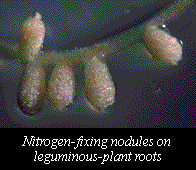Life on Earth depends heavily on microorganisms that are able to convert elemental nitrogen into compounds that are soluble in water and can be absorbed and used by plants. Once in the food chain, animals can use these nitrogen compounds for their needs.
The process where by elemental nitrogen is converted to soluble nitrogen compounds is called nitrogen fixation.


Another source of nitrogen fixation, albeit very small, is lightning. Lightning provides the energy to oxidise elemental nitrogen into nitric oxide and nitrogen dioxide according to the reaction below.
N2(g) + O2(g)
--> 2NO(g)
2NO(g) + O2(g) -->2NO2(g)
Nitrogen dioxide reacts with water in the atmosphere to produce nitric acid according to the reaction below.
2NO2(g) + H2O(l) --> 2HNO3(aq)